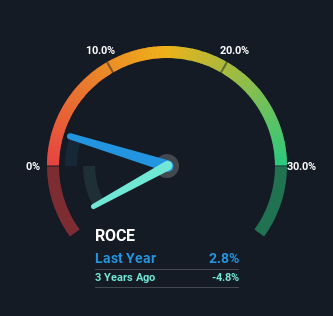- Hong Kong
- /
- Construction
- /
- SEHK:750
Capital Allocation Trends At China Shuifa Singyes Energy Holdings (HKG:750) Aren't Ideal

There are a few key trends to look for if we want to identify the next multi-bagger. Firstly, we'd want to identify a growing return on capital employed (ROCE) and then alongside that, an ever-increasing base of capital employed. Ultimately, this demonstrates that it's a business that is reinvesting profits at increasing rates of return. However, after investigating China Shuifa Singyes Energy Holdings (HKG:750), we don't think it's current trends fit the mold of a multi-bagger.
What Is Return On Capital Employed (ROCE)?
Just to clarify if you're unsure, ROCE is a metric for evaluating how much pre-tax income (in percentage terms) a company earns on the capital invested in its business. Analysts use this formula to calculate it for China Shuifa Singyes Energy Holdings:
Return on Capital Employed = Earnings Before Interest and Tax (EBIT) ÷ (Total Assets - Current Liabilities)
0.028 = CN¥313m ÷ (CN¥19b - CN¥8.3b) (Based on the trailing twelve months to June 2023).
Therefore, China Shuifa Singyes Energy Holdings has an ROCE of 2.8%. In absolute terms, that's a low return and it also under-performs the Construction industry average of 7.5%.
See our latest analysis for China Shuifa Singyes Energy Holdings

While the past is not representative of the future, it can be helpful to know how a company has performed historically, which is why we have this chart above. If you're interested in investigating China Shuifa Singyes Energy Holdings' past further, check out this free graph of past earnings, revenue and cash flow.
How Are Returns Trending?
When we looked at the ROCE trend at China Shuifa Singyes Energy Holdings, we didn't gain much confidence. Over the last five years, returns on capital have decreased to 2.8% from 11% five years ago. Given the business is employing more capital while revenue has slipped, this is a bit concerning. If this were to continue, you might be looking at a company that is trying to reinvest for growth but is actually losing market share since sales haven't increased.
Another thing to note, China Shuifa Singyes Energy Holdings has a high ratio of current liabilities to total assets of 43%. This can bring about some risks because the company is basically operating with a rather large reliance on its suppliers or other sorts of short-term creditors. While it's not necessarily a bad thing, it can be beneficial if this ratio is lower.
Our Take On China Shuifa Singyes Energy Holdings' ROCE
From the above analysis, we find it rather worrisome that returns on capital and sales for China Shuifa Singyes Energy Holdings have fallen, meanwhile the business is employing more capital than it was five years ago. It should come as no surprise then that the stock has fallen 58% over the last three years, so it looks like investors are recognizing these changes. Unless there is a shift to a more positive trajectory in these metrics, we would look elsewhere.
Like most companies, China Shuifa Singyes Energy Holdings does come with some risks, and we've found 1 warning sign that you should be aware of.
While China Shuifa Singyes Energy Holdings isn't earning the highest return, check out this free list of companies that are earning high returns on equity with solid balance sheets.
New: AI Stock Screener & Alerts
Our new AI Stock Screener scans the market every day to uncover opportunities.
• Dividend Powerhouses (3%+ Yield)
• Undervalued Small Caps with Insider Buying
• High growth Tech and AI Companies
Or build your own from over 50 metrics.
Have feedback on this article? Concerned about the content? Get in touch with us directly. Alternatively, email editorial-team (at) simplywallst.com.
This article by Simply Wall St is general in nature. We provide commentary based on historical data and analyst forecasts only using an unbiased methodology and our articles are not intended to be financial advice. It does not constitute a recommendation to buy or sell any stock, and does not take account of your objectives, or your financial situation. We aim to bring you long-term focused analysis driven by fundamental data. Note that our analysis may not factor in the latest price-sensitive company announcements or qualitative material. Simply Wall St has no position in any stocks mentioned.
About SEHK:750
China Shuifa Singyes Energy Holdings
An investment holding company, designs, fabricates, and installs conventional curtain walls in the People’s Republic of China.
Slightly overvalued with imperfect balance sheet.
Market Insights
Community Narratives




